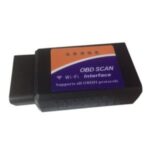For car owners and DIY mechanics, understanding what’s happening under the hood is becoming increasingly important. Modern vehicles are complex machines filled with sensors and computer systems, and when something goes wrong, it can feel like trying to solve a mystery. This is where OBD2 diagnostic tools come into play, acting as a vital link between you and your car’s onboard computer. But with a market flooded with options, the burning question is: What Is The Best Obd2 Diagnostic Tool for your needs?
Decoding the OBD2 Diagnostic Tool
An OBD2 diagnostic tool, at its core, is a device that communicates with your car’s On-Board Diagnostics system – specifically the OBD2 system, which has been standard in most cars sold in the USA since 1996. Think of it as a translator that speaks “car language.” This system monitors various aspects of your vehicle’s performance, from engine emissions to transmission health, and logs potential issues as “fault codes”.
Traditionally, an OBD2 reader was a dedicated handheld device. These scanners plug into your car’s OBD2 port, typically located under the dashboard, and allow you to perform a few key functions:
- Read Fault Codes: This is the primary function. When your car detects a problem, it generates a fault code. The OBD2 tool reads these codes, giving you a starting point for diagnosis.
- Clear Fault Codes: Once a problem is fixed, or sometimes even just to reset after troubleshooting, you can use the tool to clear these codes and turn off the dreaded “check engine light.”
- Vehicle Communication: Fundamentally, the tool establishes communication with your vehicle’s computer to access diagnostic information.
It’s important to note that while basic OBD2 scanners are incredibly helpful for reading and clearing engine-related fault codes, they generally don’t delve into more advanced functions like resetting service lights for systems like ABS, SRS (airbags), or oil life monitors. For these, you might need more specialized tools or software, or resources like Haynes AutoFix which can guide you through these processes.
Why Invest in an OBD2 Diagnostic Tool?
The value of an OBD2 diagnostic tool lies in its ability to empower you to take control of your car maintenance and repairs. Consider this scenario: your “check engine light” illuminates. Without an OBD2 scanner, your next step is likely a trip to the local garage. While professional mechanics are essential for complex repairs, simply identifying the fault code at a garage can incur costs – with labor rates averaging significant amounts per hour. An OBD2 scanner, often costing less than a single hour of garage labor, allows you to:
- Save Money: Diagnose problems yourself initially, potentially avoiding unnecessary garage visits for simple code reading.
- Save Time: Quickly identify issues instead of relying on garage appointments, especially useful for urgent problems.
- Gain Knowledge: Understand your car better by learning about fault codes and potential issues.
- Make Informed Decisions: Before taking your car to a mechanic, knowing the fault code allows you to research the problem and have a more informed conversation about repairs needed, preventing potential overcharging or unnecessary work.
- DIY Repairs: For many common issues, knowing the fault code, combined with resources like repair manuals or online guides, can enable you to perform repairs yourself at home with basic tools.
Finding Your Best OBD2 Diagnostic Tool
The “best” OBD2 diagnostic tool isn’t a one-size-fits-all answer. It depends on your needs, budget, and technical expertise. The market offers a wide range, from basic, budget-friendly readers to advanced, feature-rich professional-grade scanners. When considering what is the best OBD2 diagnostic tool for you, think about these factors:
- Functionality: Basic tools read and clear codes. More advanced tools might offer live data streaming (showing real-time sensor readings), advanced system diagnostics (beyond engine codes), bi-directional control (ability to command the car’s systems to perform tests), and more. Decide what level of functionality you need. For simple DIY, a basic reader might suffice. For more in-depth diagnostics, consider advanced options.
- Ease of Use: Some tools are incredibly simple to use with a basic interface, while others have more complex menus and features. Choose a tool that matches your comfort level with technology.
- Compatibility: Ensure the tool is compatible with your car’s make and model. Most OBD2 tools are universally compatible with OBD2 compliant vehicles (post-1996 in the US), but it’s always wise to double-check, especially for older or non-standard vehicles.
- Form Factor: Consider handheld scanners versus smartphone-based OBD2 adapters that connect via Bluetooth or Wi-Fi and use an app. Smartphone-based options can be more versatile and often leverage the processing power of your phone, but handheld scanners offer dedicated functionality.
- Budget: Prices range significantly. Basic readers can be very affordable, while professional-grade scanners can be a significant investment. Determine your budget and balance it with the features you require.
In conclusion, an OBD2 diagnostic tool is an invaluable asset for anyone who owns a car and wants to be more proactive about vehicle maintenance. While the market is vast, understanding your needs and considering the factors outlined above will guide you in finding what is the best OBD2 diagnostic tool to keep your car running smoothly and your repair costs in check. By empowering yourself with the ability to read and understand your car’s diagnostic information, you’re taking a significant step towards smarter and more cost-effective car ownership.
